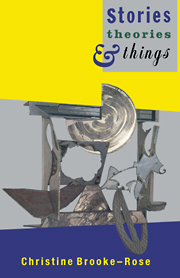Book contents
- Frontmatter
- Contents
- Preface
- Acknowledgements
- Part I Theories as stories
- Part II Stories and style
- Part III Theories of stories
- 10 Fiction, figment, feign
- 11 Which way did they go? Thataways
- 12 Palimpsest history
- 13 Illusions of parody
- 14 Illusions of anti-realism
- 15 A womb of one's own?
- Part IV Things?
- References
- Index
13 - Illusions of parody
Published online by Cambridge University Press: 20 August 2009
- Frontmatter
- Contents
- Preface
- Acknowledgements
- Part I Theories as stories
- Part II Stories and style
- Part III Theories of stories
- 10 Fiction, figment, feign
- 11 Which way did they go? Thataways
- 12 Palimpsest history
- 13 Illusions of parody
- 14 Illusions of anti-realism
- 15 A womb of one's own?
- Part IV Things?
- References
- Index
Summary
I would like to take up a problem I left unresolved in my book A Rhetoric of the Unreal (1981), namely the problem of parody. All the more so because Brian McHale, in Postmodernist Fiction (1987), a book I have already quoted and much admire, takes me to task on this problem. I shall not go into a private polemic with him, for in fact (to my surprise) we basically agree.
Parody and stylization
Christine Brooke-Rose has described Thomas Pynchon's V (1963) as a parody of classic realist fiction, and not a very satisfactory parody at that, since the crucial distance between the parody and the model being parodied is not scrupulously enough maintained. I disagree; by my reading, V is not a parody but a stylization, and not of classic realism but of modernist fiction – like Molloy, La Jalousie, Lolita, and other texts of stylized modernism.
(McHale, 21)He goes on to say that I draw my distinction parody vs. stylization from Bakhtin, which is true, and I shall do so again. However, since I had in fact called Pynchon ‘ostensibly parody, towards stylization’ (p. 385), and since the techniques supposedly stylized are (as in many postmodern novels, see Ch. 14) those of the realistic novel taken over by Modernism and already parodied by Joyce (for example, defocalization of the hero, pushed to excess, or ‘free indirect discourse’), McHale's objections seem a quibble of terms.
- Type
- Chapter
- Information
- Stories, Theories and Things , pp. 191 - 203Publisher: Cambridge University PressPrint publication year: 1991

